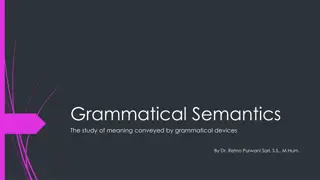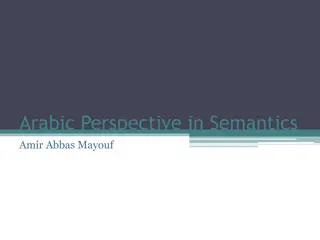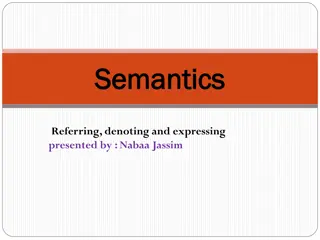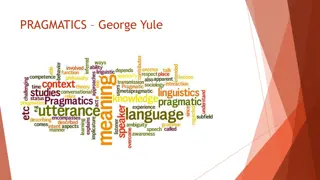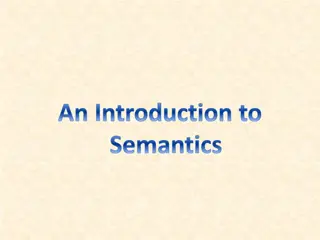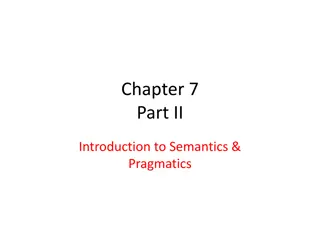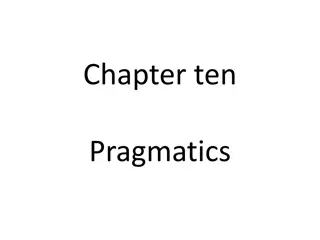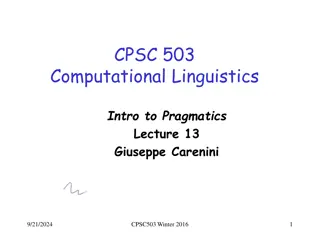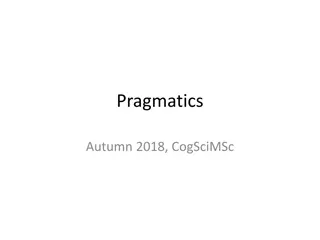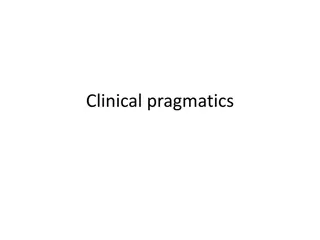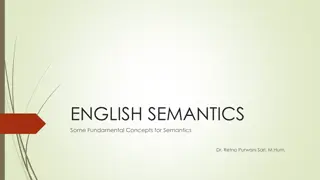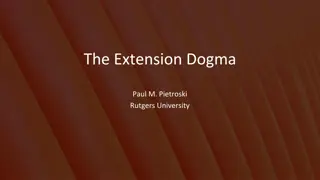Understanding Semantics and Pragmatics: Exploring Extensions of Meaning
This chapter delves into the realms of semantics and pragmatics, exploring literal and non-literal meanings, naturalized, established, and nonce extensions, as well as metaphor and metonymy. It discusses how certain meanings become entrenched in language, either as naturalized or established extensions. Additionally, it touches upon nonce readings, where strategies like metaphor and metonymy are employed for interpretation. The concept of metaphor is also examined, highlighting how words or phrases can signify meanings beyond their literal interpretations.
Download Presentation

Please find below an Image/Link to download the presentation.
The content on the website is provided AS IS for your information and personal use only. It may not be sold, licensed, or shared on other websites without obtaining consent from the author. Download presentation by click this link. If you encounter any issues during the download, it is possible that the publisher has removed the file from their server.
E N D
Presentation Transcript
Chapter 11 Introduction to Semantics and Pragmatics
Chapter 11 CHAPTER 11 Extensions of meaning 11.1 Literal and non-literal meaning 11.2 Naturalized, established, and nonce extensions 11.3 Metaphor 11.4 Metonymy 11.5 Semantic change
11.2 Naturalized, established, and nonce extensions 11.2.1 Naturalized extensions What is historically no doubt an extended meaning may be so entrenched and familiar a part of a language that its speakers no longer feel that a figure of speech is involved at all: such readings of a word (or expression) will be said to be naturalized: (4) He's in love. (5) It's hard to put into words. (6) The kettle's boiling.
11.2 Naturalized, established, and nonce extensions 11.2.2 Established extensions There are also readings which are well established, and presumably have entries in the mental lexicon, but are none the less felt to be figures of speech: (7) John's a parasite/a lounge lizard/a couch potato. (8) She swallowed the story. (9) There are too many mouths to feed.
11.2 Naturalized, established, and nonce extensions 11.2.3 Nonce readings Nonce readings are ones for which there are no entries in the mental lexicon; they therefore cannot be 'looked up', but have to be generated and interpreted using strategies of meaning extension such as metaphor and metonymy. The following are selected (almost) at random from Patricia Cornwell's best-seller Hornet's Nest: (10) West gave him a look that was heat-seeking, like a missile. (11) He had never told her his fantasies about being overpowered by her, cuffed, pinned, held, yoked, and hauled away in the paddy wagon of erotic captivity. (12) His heart rolled forward at such a pitch, he could not catch up with it.
11.3 Metaphor A typical dictionary definition of metaphor is: "The use of a word or phrase to mean something different from the literal meaning" (Oxford Advanced Leaner's Dictionary). This is not very enlightening.
11.3.1 Approaches to metaphor The Greek word from which the term metaphor originated literally meant "transfer". For Aristotle, what was transferred was the meaning of one expression to another expression: for him, a metaphorical meaning was always the literal meaning of another expression. (This is the so- called substitution view of metaphor.) Although Aristotle recognized the crucial role of resemblance in metaphor, in the classical tradition, metaphor was regarded essentially as a decorative device.
11.3.1 Approaches to metaphor I.A. Richards (1965) made a distinction between three aspects of metaphor: vehicle, the item(s) used metaphorically, tenor, the metaphorical meaning of the vehicle, and ground, the basis for the metaphorical extension, essentially the common elements of meaning, which license the metaphor. For example, in the foot of the mountain, the word foot is the vehicle, the tenor is something like "lower portion", that is, the intended meaning of the vehicle, and the ground (never properly spelled out by Richards) is (presumably) the spatial parallel between the position of the foot relative to the rest of the (human) body, and the lower parts of a mountain relative to the rest of the mountain.
11.3.1 Approaches to metaphor 11.3.1.1 Haas: the interaction of semantic fields A more thoroughgoing interaction theory, and more solidly grounded in language, was that of Haas. For Haas, the meaning of a word constituted a 'semantic field'. This consisted of all the possible contexts of the word organized in terms of normality, the most normal contexts forming the 'core' region of the field, and the least normal forming the periphery. When two words were brought into interaction, a new semantic field was created, whose core was formed by the contexts with the highest joint degree of normality for both words. This new semantic field defined a new meaning, the metaphoric one.
11.3.1 Approaches to metaphor 11.3.1.4 Lakoff According to Lakoff, metaphors are not merely decorative features of certain styles, but are an essential component of human cognition. Nor are they purely linguistic, but are conceptual in nature. They are 'a means whereby ever more abstract and intangible areas of experience can be conceptualised in terms of the familiar and concrete'. Metaphors involve (i) a source domain, usually concrete and familiar, (ii) a target domain, usually abstract or at least less well structured, and (iii) a set of mapping relations, or correspondences.
For example, the ARGUMENT is WAR metaphor uses notions drawn from the domain of war, such as winning and losing, attacking and defending, destroying, undermining, and so on, to depict what happens during an argument. Likewise, the LIFE is a JOURNEY metaphor borrows structuring ideas from the domain of a journey and applies them to life: We've come a long way together, but we have decided to take our separate paths, He has come to a crossroads in his life, This young man will go far.
11.3.2 Close relatives of metaphor 11.3.2.1 Personifications 11.3.2.2 Proverbs
11.4 Metonymy 11.4.1 Metonymy vs. metaphor The difference between metaphor and metonymy is highlighted by Jakobson and Halle (1956), who said that metaphor was based on resemblance, whereas metonymy was based on "association". Jakobson's dictum captures some of the difference between metaphor and metonymy, but leaves an important point unhighlighted. Metaphor involves the use of one domain as an analogical model (in Black's terms) to structure our conception of another domain; in other words the process crucially involves two (in the simplest cases) distinct conceptual domains. Metonymy, on the other hand, relies on an (actual, literal) association between two components within a single domain (and no restructuring is involved). Take the famous ham sandwich case: (30) The ham sandwich wants his coffee now. This is, of course, caf language , but is perfectly intelligible to all. The domain invoked is a cafe, or similar establishment, where a customer is (perhaps momentarily) distinguished by the fact that he has ordered a ham sandwich.
11.4.2 Patterns of metonymy (i) CONTAINER for CONTAINED (32) The kettle's boiling. (ii) POSSESSOR for POSSESSED/ATTRIBUTE (37) Where are you parked? (38) Shares fall 10 per cent after Budget. (iii) REPRESENTED ENTITY for REPRESENTATIVE (39) England won the World Cup in 1966. (iv) WHOLE for PART (42) Do you need to use the bathroom? (v) PART for WHOLE (43) There are too many mouths to feed. (vi) PLACE for INSTITUTION (46) The White House denies the allegations. (47) The Palace defends the sackings.
11.4.3 What is metonymy for? (i) economy; (ii) ease of access to referent; (iii) highlighting of associative relation.
11.5 Semantic change Historical processes of semantic change are of course intimately linked to synchronic processes of meaning extension




